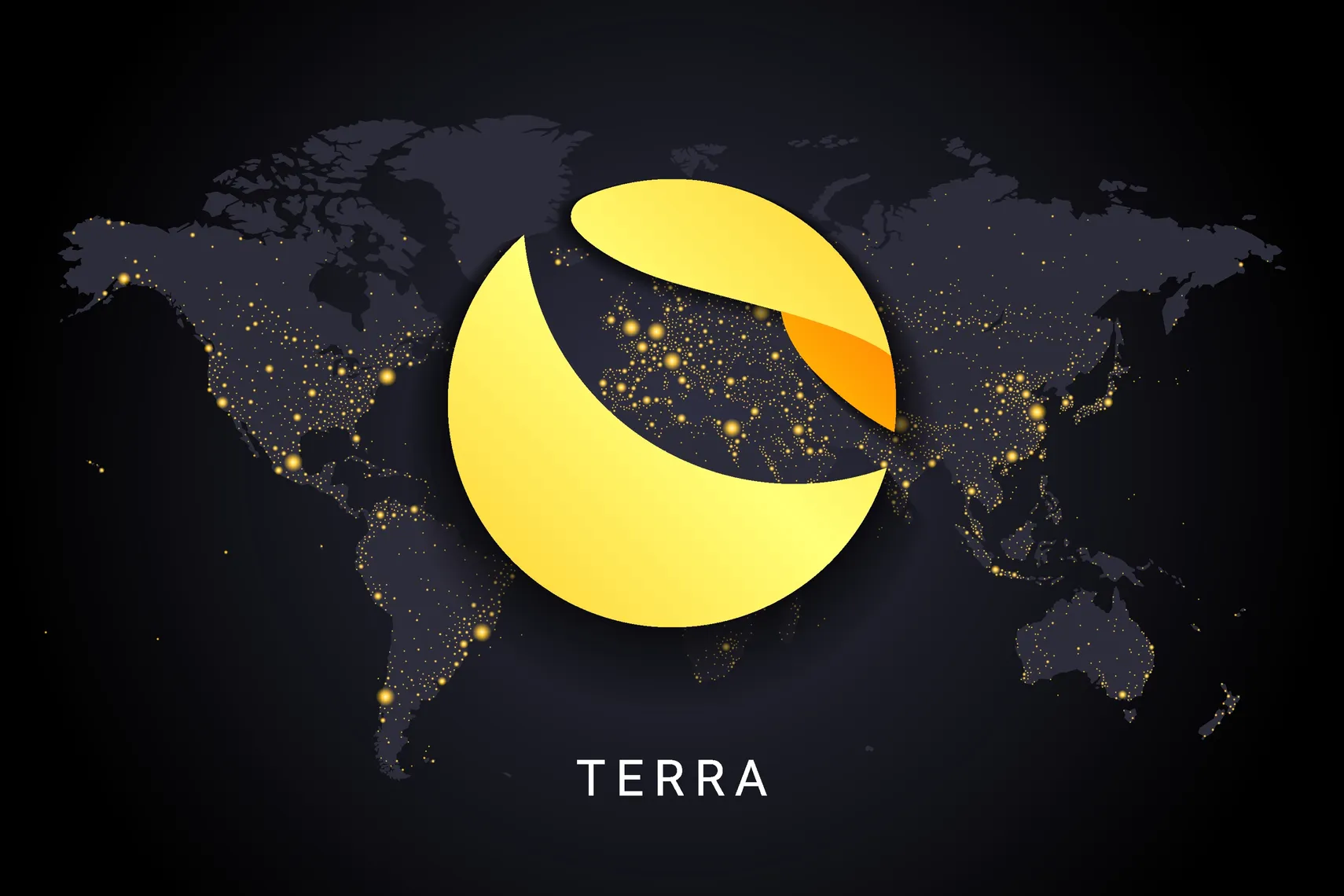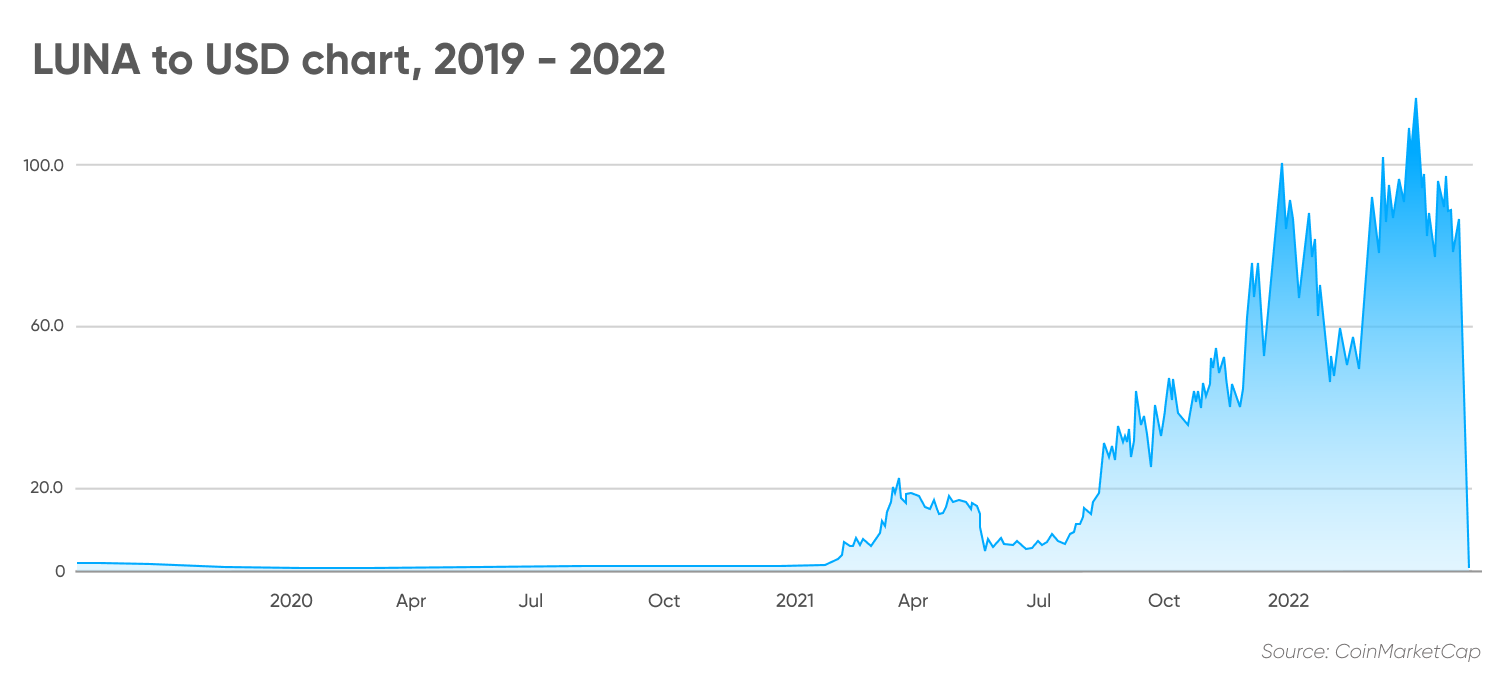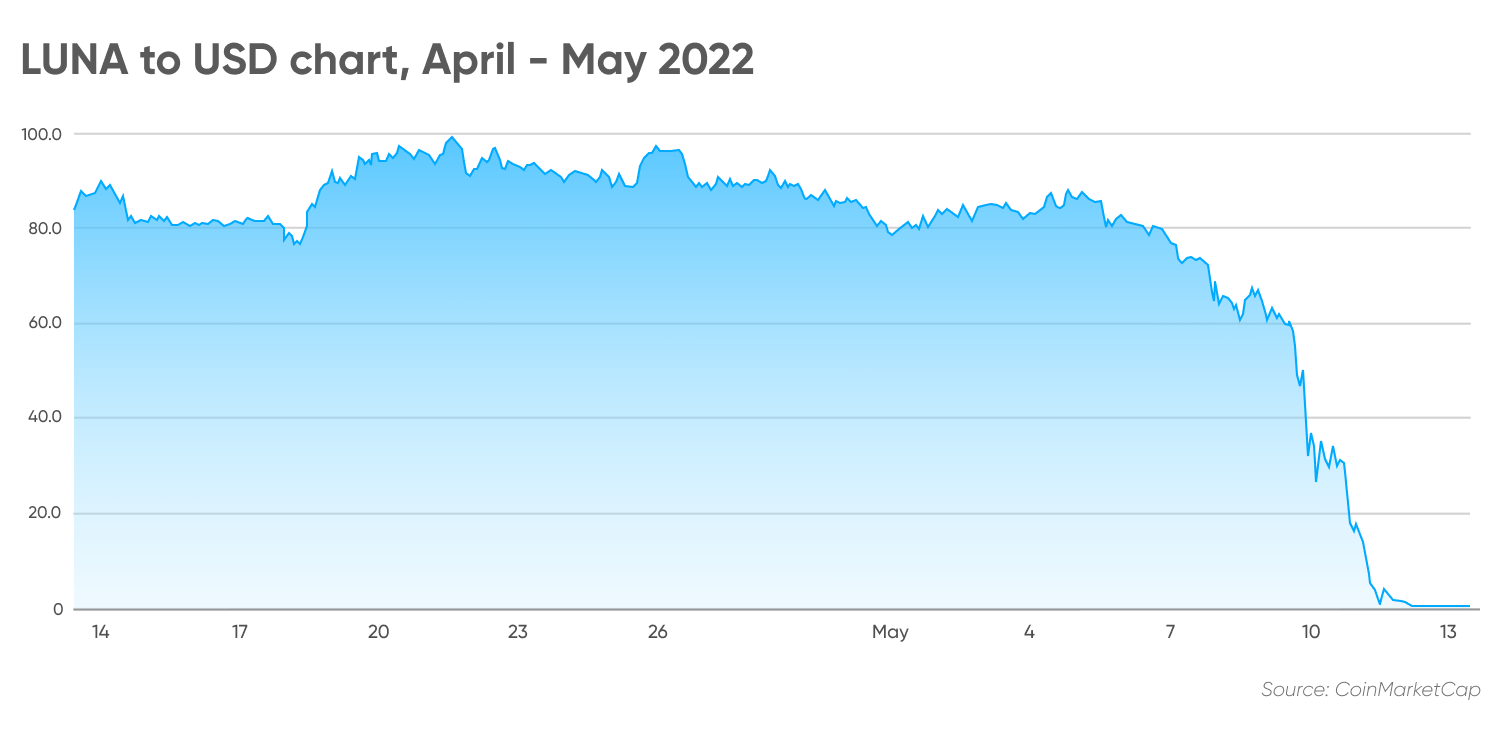Terra price prediction: What is terra (LUNA)?
What happens next to LUNA after Do Kwon's arrest?
It has struggled to make a comeback since the dark days of May 2022 and the news that its founder has been arrested also had an impact on its price but what is terra (LUNA)?
Let’s take a look and see what we can find out, and also examine some of the terra price predictions that were being made as of 14 April 2022.
In late May 2022, Terra’s community voted in favour of founder Do Kwon’s proposal to create a new blockchain, commonly referred to as Terra 2.0. The old blockchain was renamed Terra Classic and its token was rebranded as luna classic (LUNC).
The new Terra 2.0’s native token LUNA or LUNA2 (as listed on various exchanges) was airdropped to holders of old terra tokens in the days that followed.
Most importantly, the Terra 2.0 chain chose to abandon its flagship yield-generating stablecoin UST, in a bid to rebuild again with a clean slate.
As of 28 March 2023, both the old and new Terra chains continue to coexist in parallel following the hard fork.
The rise and fall of Terra
Before the collapse of Terra’s algorithmic stablecoin UST and its native token in May 2022, the blockchain was a thriving network which focused on decentralised finance (DeFi).
Yield-seeking investors from far and wide flocked to Terra’s passive income protocol Anchor (ANC) for its 20% interest rate on UST deposits, which in turn drove demand for UST and the old LUNA token.
At its peak in April 2022, Terra’s native token boasted a market capitalisation of over $41bn, and was among the top 10 largest cryptocurrencies in the world.
Historical data from analytics website DefiLlama showed that Terra was also among the top three blockchain networks in terms of total value locked (TVL), with over $21bn in TVL at its peak.

Terra’s fortune took a drastic turn in early May 2022 when its ecosystem saw capital flight, following the depegging of algorithmic stablecoin UST and a plunge in what would become LUNC prices.
Investors who were once drawn to near 20% returns on UST deposits began to withdraw and sell their UST tokens in a frenzied exit, as UST began losing its dollar peg on 9 May 2022. As more UST holders sold their tokens, LUNC – which was designed to be a balancing token to help maintain UST’s dollar peg – saw hyperinflation.
Between 9 May and 12 May, LUNC lost nearly all of its value as it dropped by 99.98% from about $64 to $0.0087. UST, which was designed to be worth $1, plunged to $0.25 in the same period.
Cascading effects from the Terra crisis engulfed a cryptocurrency market that was already weakened by difficult macroeconomic conditions.
Three Arrows Capital (3AC), a billion dollar crypto hedge fund that had exposure to Terra’s ecosystem, went bankrupt as falling crypto prices forced liquidations of collateralised loans and leveraged trading positions across the industry, aggravating the sell-off. Investor sentiment plummeted as crypto lending platforms like Celsius (CEL) and Babel suspended withdrawals for clients.
Analysts at Saxo Bank noted that Terra’s collapse and its ripple effects on the crypto market could result in stricter market regulation.

Founder profile: Do Kwon
Terra was founded in 2018 by Daniel Shin and Do Kwon, with the aim of driving blockchain and cryptocurrency adoption by focusing on usability and price stability.
Kwon is the CEO of Terraform Labs, the entity behind Terra. Kwon was previously the CEO and founder of decentralised wireless mesh networking start-up Anyfi. He also worked as a software engineer at Apple (AAPL) and Microsoft (MSFT).
According to his LinkedIn profile, Kwon studied computer science at Stanford University in California from 2010 to 2015.
Kwon is the face of Terra. He is known to have an outspoken personality and has used Twitter to voice his bullish opinions about the Terra ecosystem on numerous occasions.
Meanwhile, Shin previously co-founded and led the South Korean e-commerce platform Ticket Monster, as well as start-up incubator Fast Track Asia.
After the collapse of Terra, many investors have filed lawsuits against Kwon and other Terra entities for misleading investors. On 12 June, Kwon denied claims that he allegedly cashed out $2.7bn in the months leading up to the collapse of Terra.
Things got even worse in September, when South Korean authorities asked that he be given a ‘red notice’ (a request to law enforcement worldwide to locate and provisionally arrest a person pending extradition, surrender, or similar legal action) by Interpol, while October saw Kwon deny that his assets had been seized.
As of 12 December, the Seoul Southern District Prosecutors’ Office said it believed Kwon was in Serbia.
On March 22 2023, Kwon was arrested in Montenegro and later that month charged with fraud by American prosecutors.
Looking forward: What is Terra 2.0?
The Terra Ecosystem Revival Plan was passed by the Terra community on 25 May 2022, and approved the creation of a new blockchain and a new native token.
According to Terra’s website, the new Terra 2.0 network launched on 27 May 2022. The new LUNA token was distributed to LUNC stakers, LUNC and UST holders and essential app developers of the old Terra chain.
“The proposal allocates a large portion of the token distribution to provide runway for existing Terra dApp developers and to align the interest of developers with the long-term success of the ecosystem,” tweeted Terra.
According to Terra, new LUNA tokens were not distributed to Terraform Labs (TFL) and Luna Foundation Guard (LFG), two leading entities behind the old Terra chain.
“Lastly, while TFL intends to continue supporting and building on the Terra 2.0 network, it is not by any means a ‘TFL-led’ chain – we consciously bowed out of airdrop allocations and all the decisions are being made by various community groups, albeit in a rocky fashion,” tweeted Do Kwon on 9 June.
According to Terra, 30% of a user’s LUNA token allocation can be freely traded at genesis but 70% of the allocation will be locked for six months. After six months, small portions of the 70% will be released with every block added to the Terra 2.0 chain for two years.
“After two years, all the airdropped Luna will have been released, and the vesting will be complete,” said Terra.
According to Terra, the initial supply of LUNA at the genesis of the new chain was one billion coins. New coins will be released with every block as staking rewards, at a default rate of about 7% per annum. Users on the new chain will be able to vote on improvement proposals after depositing a minimum of 50 LUNA tokens.
Like the old chain, Terra 2.0 will continue to be a proof-of-stake blockchain built on the Cosmos (ATOM) network and secured by Cosmos-native Tendermint consensus.
According to Terra-based analytics firm Coinhall, about 88 projects have expressed interest in supporting the Terra 2.0 ecosystem. The list includes decentralised exchange Astroport, blockchain infrastructure provider Illiquidity, non-fungible token (NFT) protocol Galactic Punks and payment platform Outlet Finance among others. The majority of the projects on the list previously existed on the old Terra chain.
Terra 2.0 remains a shadow of its former self. Before its collapse, Terra was among the top three blockchain networks in terms of TVL, alongside the likes of Ethereum (ETH) and Binance Smart Chain (BNB).
On 13 July 2022, CoinGecko said in its Q2 2022 Cryptocurrency Report :
LUNA price history
Let’s now cast our eyes over what the new form of LUNA has done since it came out. Remember, past performance should never be taken as an indicator of future results. That said, knowing what LUNA has done since it was relaunched can help give us some much needed context if we want to either interpret a terra price prediction that's already out there or else make one of our own.
New LUNA tokens or LUNA2 tokens (as they are referred to by some crypto exchanges) were airdropped to eligible wallet addresses on 28 May 2022.
The new LUNA coin opened at a price of $18.98 on 28 May but immediately plummeted in value to end the day at $4.94.
Although the price moved back up to $11.97 on 30 May 2022, it fell again and by 8 June reached an intraday low of $1.96. Things got worse after the cancellation of withdrawals on the Celsius (CEL) crypto lending platform confirmed the bear market, and LUNA sank to a low of $1.66 on 18 June.
While there was some recovery after that, with LUNA trading at above $2 in early July and the start of April, there was still downward pressure and, on 29 August 2022, the coin reached an all-time low of $1.53.
There was then some recovery, and on 10 September it reached a high of $7.06 before dropping down . By 5 November it was worth $2.70 which was, admittedly, up from a low of $2.26 it reached just three days prior. But following that, disaster struck. The collapse of the FTX (FTT) exchange caused yet another crash and LUNA fell to a low of $1.44 on 22 November 2022.
When Kwon accused FTX founder Sam Bankman-Fried of being at least partially responsible for the downfall of UST, the markets were not too impressed and, on 16 December, LUNA fell to $1.17, making a very modest recovery to close the year at about $1.26.
Things looked to be getting better in 2023, when a bull run in late January saw it reach a high of $2.52 on 21 January, before a slow decline, exacerbated by the collapse of the Silvergate bank and Kwon's arrest, saw it trade at around $1.25 on 28 March before surging to a high of $1.50 on 12 April and falling back to $1.42 on 14 April 2023.
At that time, there were 252,495,792 LUNA in circulation out of a total supply of 1,004,262,701. This gave it a market cap of around $358m, making it the 109th-largest crypto by that metric.
LUNA price predictions
With that all said and done, let's examine some of the terra price predictions that were being made as of 14 April 2023. It is important to remember that price forecasts, especially for something as potentially volatile as cryptocurrency, very often end up being wrong.
First, CoinCodex made a short-term terra price prediction for 2023 that argued the coin could drop to $1.35 by 19 April before falling further to a little under $0.93 on 15 May. The site’s technical analysis was, perhaps surprisingly, neutral, with 16 indicators sending out bullish signals against eight making bearish ones.
DigitalCoinPrice was more bullish in terms of a long-term terra coin price prediction. According to its terra price prediction for 2030, DigitalCoinPrice expected the token to potentially trade at an average price of $20.23 that year.
LongForecast’s terra crypto price prediction held a bearish view on the future of LUNA. It saw the token closing 2023 at $1.15. The site’s terra price prediction for 2025 saw the LUNA token open the year at $0.71, drop to $0.69 in April, and potentially close the year at $0.72.
Finally, Wallet Investor was also pessimistic when it came to making its LUNA price prediction. The site said that the coin could fall to a mere $0.0552 by the middle of April next year.
When considering a LUNA coin price prediction, it’s important to keep in mind that cryptocurrency markets remain extremely volatile, making it difficult to accurately predict what a coin or token’s price will be in a few hours, and even harder to give long-term estimates. As such, analysts and algorithm-based forecasters can and do get their predictions wrong.
If you are considering investing in cryptocurrency tokens, we recommend that you always do your own research. Look at the latest market trends, news, technical and fundamental analysis, and expert opinion before making any investment decision. Keep in mind that past performance is no guarantee of future returns, and never trade with money that you cannot afford to lose.
FAQs
Is terra a good investment?
It might be, it might not be – it is still, perhaps, a little too early to say. The new LUNA coin, the native token of the Terra 2.0 chain, was only launched after the collapse of the original Terra crypto in May 2022.
Remember, you should always carry out your own thorough research before making an investment. Even high market cap cryptocurrencies have proved vulnerable to the current bear market, so investors should be prepared to make losses and never purchase more than they can afford to lose.
Will terra go up or down?
It is hard to say. While the likes of DigitalCoinPrice were upbeat and optimistic about LUNA’s future as of 14 April 2023, other sites such as LongForecast were more downbeat and bearish. Remember, too, that prices can go down as well as up, and that price predictions often end up being wrong.
In volatile cryptocurrency markets, it is important to do your own research on a coin or token to determine if it is a good fit for your investment portfolio. Whether LUNA is a suitable investment for you depends on your risk tolerance and how much you intend to invest, among other factors.
Keep in mind that past performance is no guarantee of future returns, and never invest money that you cannot afford to lose.
Should I invest in Terra?
Ultimately, this is a question that you will have to answer for yourself. Before you do so, however, you will need to conduct your own research. It is worth remembering, before you make a decision as to whether or not to invest in LUNA, that the crypto is the successor to a coin that failed. You should be careful.
Never invest more money than you can afford to lose, because prices can go down as well as up.